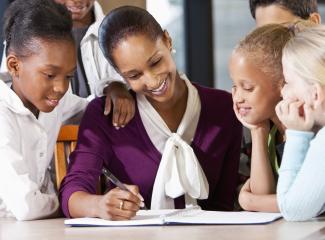
By Clare Berke
When I was in fifth grade, my teacher gave my best friend and me free time during the week to do an activity of our choice. Using Macintosh Classics and dot matrix printers, we made a newspaper. I do not remember the stories we covered, but I do remember how much I loved writing and designing a publication. And although I never became a professional journalist, I have remained committed to the field during my 15 years teaching and sponsoring extracurricular activities in Washington, D.C., public schools.
Journalism is a career and technical education course, and at Benjamin Banneker Academic High School, it is one of the electives seniors can choose among a plethora of Advanced Placement courses offered in numerous disciplines. An academic magnet school that opened its doors in the 1980s, our school was college preparatory long before “college for all” entered the educator lexicon.
Our students, who hail from all areas of the city and who mostly identify as Black and Latinx, are going to four-year institutions. They will become teachers, doctors, lawyers, politicians, academics, technology leaders and communication specialists. So, it makes sense that there is ample demand for journalism, a CTE course that exercises essential literacy skills — speaking, listening, reading, writing and multimedia — all while encouraging students to take the lead on projects that interest and motivate them.
My students took notes, asked questions and snapped pictures. Perhaps as important, they dressed the part as they tried on the career for a day.
Two of my students recently served as journalists at the Albert Shanker Institute’s Passion Meets Purpose conference, which gathered educators, lawmakers and members of the technology industry to discuss the role of experiential learning in education today. My students took notes, asked questions and snapped pictures. Perhaps as important, they dressed the part as they tried on the career for a day.
One of those same students came to me this week to discuss a new article she wants to begin. It is about a school in nearby Maryland, which, according to her source, has numerous structural and community problems. Who should she talk to first? she wondered. Her new friend, Governor Wes Moore, who she met at the conference?
Together, we began to investigate. We looked online at the school, the city, the school board and the locally elected officials. We discussed the possibility that she might go to the building to see it for herself and to conduct interviews. She spoke to her science teacher about how to test the school’s water for contaminants. Then, we brainstormed professional journalists we know who might be able to provide advice.
Helping students research, write and find their voices has sustained me throughout my career in education.
A connection to professionals working in the field has been essential to my own development as a journalism teacher. Over the years, I have worked with volunteers through the Journalism Education Association, the National Press Club, Report for America, the Maryland-D.C. Scholastic Press Association, the Pulitzer Center on Crisis Reporting, the Washington Informer and the Washington Post. I have learned alongside my students; and a few years ago, I even got to help a journalist develop the journalism curriculum for our school system. Having these sorts of partnerships strengthens our reach and expands the number of adults available to help our kids learn.
In my class this spring, I have 20 seniors who run our school’s news website. They are organized into editors and reporters, and they are responsible for setting and meeting deadlines. I serve as publication adviser and provide general support. Their stories, editorials and photographs allow for conversations that remind me of my college writing courses — What information is missing? What word serves this purpose? Do we need this sentence? I have heard the journalists I have been lucky to work with have these same conversations with each other.
The energy that my student brought to me this week is one of the many reasons I love teaching. Helping students research, write and find their voices has sustained me throughout my career in education.
Five years ago, students at my school also used the same skills I teach in journalism class to advocate for our current school to be built. They conducted interviews on the radio and on TV, wrote and published a print editorial, and spoke at City Council meetings. They helped develop a social media campaign, and they learned how budget cycles work and community decisions are made. It was a real-life experiential learning unit, and it is the reason we have a new, safe and beautiful school building today.
My fifth-grade teacher knew about empowering young people to follow their passions and develop their voices, and I am still inspired by her. When our students are part of experiences that pique their interests, involve their daily lives and prepare them for what comes after high school, the whole community benefits.
Clare Berke is the English Department chair at Benjamin Banneker Academic High School in Washington, D.C., where she has taught English and journalism for 15 years. Berke is an active member of the Washington Teachers’ Union and the Maryland-D.C. Scholastic Press Association.
Republished with permission from AFT Voices.
